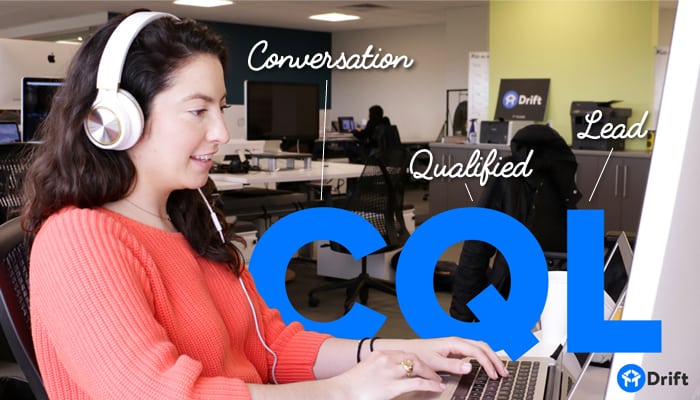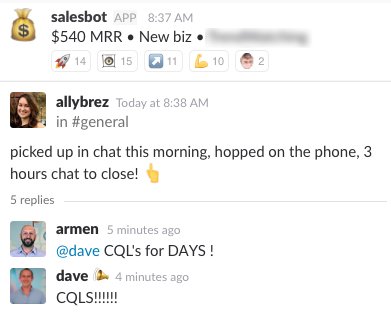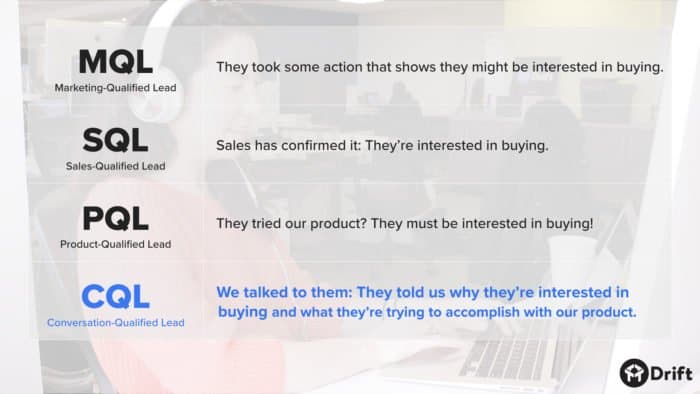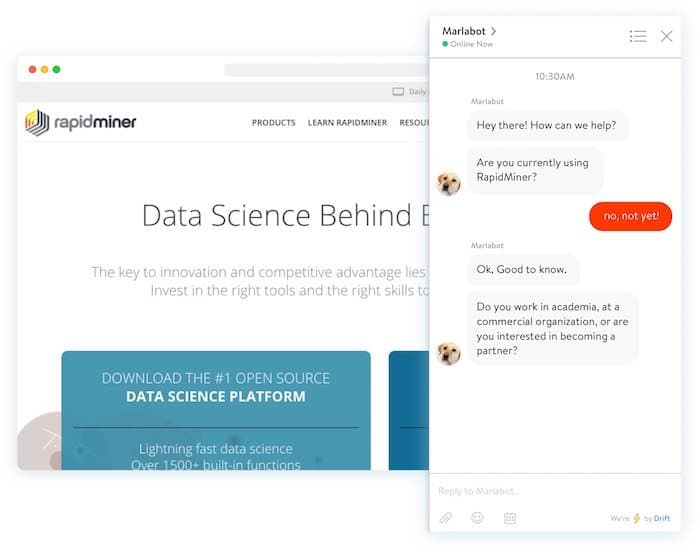
“The marketing-qualified lead is dead.”
That’s how my CEO, David Cancel, opened one of the presentations he gave last year.
His explanation:
MQLs are holdovers from the early days of SaaS, back when the needs of the customer took a backseat to the internal priorities and processes of the company.
Back then, making our potential customers go through a slow, unnecessarily complex buying process somehow seemed like a good idea (and unfortunately, it’s how lots of companies still run things):

So when we removed gated content and lead capture forms at Drift, and started making a conscious effort to put customer experience back at the center of everything we were doing, we realized that the MQL was an imperfect metric.
Becoming an MQL hinges on, well — it depends. It’s different at every company, but MQLs are typically based on some combination of demographics, firmographics, and engagement.
A common offshoot of the MQL, the sales-qualified lead (SQL), is basically the same thing, only there are more boxes that need to be ticked in order for sales to consider a lead qualified.
Then came the product-qualified lead (PQL), which offered a promising alternative: Instead of forcing people to fill out forms in order to generate leads, why not focus on getting them to sign up for a free or freemium version of your product instead?
Ultimately, however, we found that MQLs, SQLs, and PQLs all suffered from the same two issues:
- They were slow. They ignored the on-demand, real-time pace that buyers move at these days.
- The substance behind why people were deciding to buy was missing from the equation. Lots of data points were being gathered, but none of them offered the customer insights we actually needed.
So we decided to abandon MQLs, SQLs, and PQLs in favor of a new type of lead:
The conversation-qualified lead, or CQL™.
But don’t worry: This isn’t just another metric that will drive a bigger wedge between marketing and sales.
This one will actually make things easier.
The CQL™ is a metric that both our marketers and salespeople here at Drift are rallying around.
From our account executives (like Ally, see below), to our VP of Sales (Armen), to our Director of Marketing (Dave), everyone here is seeing how CQLs are transforming our sales process and allowing us to sell faster.

But what exactly is a CQL? And how can you start measuring them at your business? Here’s a quick breakdown, plus three reasons why making the switch has paid off for us.
What is a Conversation-Qualified Lead (CQL)?

For the past decade, marketing teams have been doing everything possible to game potential customers into taking certain actions so they could label them as MQLs, SQLs, or PQLs.
True, these were all convenient ways to make the marketing-to-sales hand-off more measurable. But the downside of these metrics was that they completely disregarded customer experience, and failed to take into account the underlying reasons why a customer was thinking about buying.
That’s why we came up with the conversation-qualified lead (CQL), which matches how people actually prefer to buy, and makes it easier for you, as a marketing and sales organization, to sell faster.
A CQL is someone who has expressed intent to buy during a one-to-one conversation with either A) an employee at your company, or B) an intelligent sales assistant (bot).
So you can break CQLs down into two distinct flavors:
- Human-qualified via conversation, or
- Bot-qualified via conversation
With both types of CQL, we use live chat to track all of those conversations, so we can look back and see which leads ended up booking meetings, becoming customers, etc.
In order to qualify leads using bots, we write sales scripts and have the bots ask the same questions our salespeople ask.

The benefit is that bots, unlike humans, can have conversations with leads around the clock — even when your sales reps are asleep, or on vacation. That means our leads always get a real-time response and can even schedule a demo on one of our sale rep’s calendars (even if that rep isn’t online at that particular moment).
3 Reasons Your Sales Team Will Love CQLs
1) You’re creating a fastlane for your best leads.
In a world where you can stream music and movies instantly, order a ride with the push of a button, and have just about anything (food, booze, clothes, electronics, etc.) delivered to your door within hours, why is the B2B buying process still so slow and outdated?
In a lead management survey we conducted of 433 B2B sales teams, we found that just 7% responded within five minutes of someone reaching out with a sales inquiry.
^That’s despite the fact that after that five-minute window is past, your odds of ever hearing from those leads again drop 10x.
Just signed a new Fortune 100 company that started via a @drift chat. A bot-assisted human >>> your website + email “nurturing” campaigns
— Tom Wentworth (@twentworth12) June 14, 2017
By switching to the CQL, we’ve put engaging with leads in real-time at the forefront of our sales and marketing strategy.
When people hit our site and start a chat with us, they’re automatically directed (via intelligent routing) to the person or department they’re best suited to talk to. If there’s a conversation to be had, we’re having it — no more letting leads slip through the cracks. We’re responding to all of our incoming leads in real-time and making sure the best ones get immediately passed to sales.
Not only does focusing on CQLs make the buying experience simpler and faster for your future customers, it also compresses your team’s sales cycle.
With CQLs, you can go from dealing in months and weeks to dealing in days and hours.
Just ask Chris Willis, CMO at Perfecto Mobile:
Leads that come in through chat tend to have a higher velocity. So you’re able to solve the problem or meet the needs of the request in real-time. So you think in terms of somebody coming to a website, and having a question, and filling in a contact us form. And they’ll hear back in 24 hours, or two days…that problem might not be there anymore. If they’re able to initiate a conversation, so skip the form, and have a conversation in real-time, we’re seeing that move very quickly.
And that leads us to the second reason why CQLs are so effective…
2) Conversations > Forms
CQLs aren’t only about making sales cycles faster: they’re about delivering a superior level of customer experience that’s been mostly absent from the B2B world.
By switching to the CQL, we’ve been able to get back to basics.
Instead of obsessing over attribution models and optimizing and measuring every last detail, we’ve gotten back to the core of marketing and sales, which is having conversations around your product and how it can help someone solve a problem.
For a decade now, lead capture forms have been the unholy gatekeepers of who gets to have a conversation with your company. They’ve been roadblocks on the path to people learning more and potentially becoming customers.
And that’s exactly why more and more people are ripping their lead forms out and replacing them with messaging. To quote RapidMiner CMO, Tom Wentworth:
We’ve gotten rid of traditional forms on our website for the reason that now we have so many other ways to have conversations with people. Capturing someone’s email address and relentlessly attacking them with nurturing campaigns doesn’t work anymore.
After switching from forms and follow-ups to real-time messaging, switching from MQLs to CQLs is the natural next step.
At the end of the day, an MQL is just an email address, a name, and a bunch of information that’s been entered into some fields. A CQL takes all off that basic information and pairs it with the actual conversations that person has been having with your company.
At Drift, we find that those conversations end up being way more valuable to us than any other type of data we gather.
Only through conversations can we build relationships with our customers and understand why they were drawn to our product, what they think of it, and how they derive value from it.
3) You can keep your same qualifying rules.
Just as switching from lead capture forms to messaging might have sounded crazy to some, we know that folks might be hesitant about switching to CQLs.
After all, nobody likes having to overhaul existing machinery that you’ve already got up and running.
But here’s the thing: Switching to CQLs doesn’t mean changing the way you work.
You can keep all of your lead qualification rules exactly the same — now you’re just making them actionable.
WIth CQLs, it’s not about capturing the information of people who meet your target criteria, it’s about starting conversations with those people. And the best part is that we’re harnessing the power of artificial intelligence and bots to make starting those conversations way easier.
Just check out what our pal Guillaume Cabane, VP of Growth at Segment, has been up to.
Guillaume wanted to hone in on the 10% of his website visitors who he knew were a good fit to buy. So he used Drift to a create a messaging campaign that appears only to anonymous visitors who are from companies that meet his specific lead-scoring model.

That way, he’s able to proactively start conversations with his best leads — while they’re live on the website and at their most interested — instead of passively waiting for someone to fill out a form.
Final Thought
Most of the marketing tools and strategies we rely on today are suited for a world that no longer exists.
They were created at a time when companies had all the power, and didn’t care about customer experience.
Today, whether you’re a B2B company or a B2C company, remember that you’re dealing with people. And people now expect a real-time, on-demand buying experience.
CQLs are the metric you can use for measuring that experience.
Click below to learn how Drift can help you make the switch.



